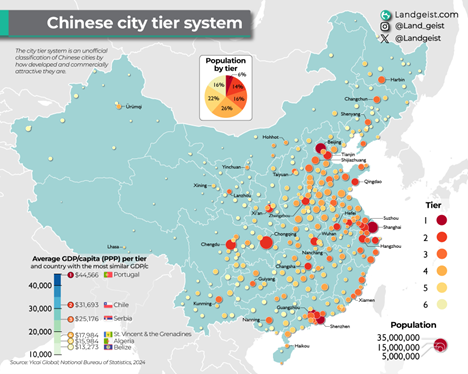For multinational corporations (MNCs) operating in China, recognizing the country’s vast regional differences is crucial for success. China is not a monolithic market—it’s a patchwork of diverse economies, consumer behaviors, regulatory environments, and business cultures. A strategy that works in Shanghai may fail in Chengdu, and a product popular in Guangdong might struggle in Shaanxi.
To navigate this complexity, executives must move beyond a one-size-fits-all approach and instead tailor their operations to local conditions. Here’s a fact-based breakdown of China’s key regional differences and how they impact business decisions.
- The Tiered City System: More Than Just Population
China’s cities are often categorized into tiers, but these classifications go beyond mere population size—they reflect economic development, infrastructure, and consumer sophistication.
- Tier 1 (Beijing, Shanghai, Guangzhou, Shenzhen): These are China’s most internationalized cities, with high disposable incomes, advanced logistics, and a strong talent pool. However, operating costs are steep, and competition is fierce.
- Example: Starbucks dominates in Tier 1 cities with premium positioning but adjusts its strategy in lower-tier markets by offering more affordable options.
- Tier 2 (Chengdu, Hangzhou, Wuhan, Nanjing): Fast-growing hubs with rising middle-class consumers. These cities often serve as regional headquarters for MNCs looking to expand beyond coastal areas.
- Example: IKEA has successfully penetrated Chengdu and Wuhan by adapting store sizes and product selections to local living spaces.
- Tier 3 & 4 (smaller cities and counties): Lower costs but require deep localization. Consumers are price-sensitive but increasingly brand-conscious.
- Example: Pinduoduo, an e-commerce platform, thrives here by focusing on group buying and ultra-low prices.
- East vs. West: The Economic Divide
China’s eastern coastal regions (Jiangsu, Zhejiang, Guangdong) contribute over 50% of national GDP, while western provinces (Gansu, Guizhou, Xinjiang) are still catching up.
- Eastern China: Strong manufacturing, export hubs, and tech innovation.
- Example: Tesla’s Gigafactory in Shanghai benefits from local supply chains and favorable policies.
- Western China: Government incentives (e.g., tax breaks, subsidies) aim to boost development. Infrastructure is improving, but talent retention is a challenge.
- Example: Intel has invested in Chengdu to leverage lower labor costs and government support for tech firms.
- North vs. South: Cultural & Consumer Differences
Beyond economics, cultural nuances shape business interactions:
- Northern China (Beijing, Tianjin, Shandong): More hierarchical business culture, with stronger government influence. Guanxi (relationships) is critical.
- Southern China (Guangdong, Fujian): Entrepreneurial, pragmatic, and faster-moving. Shenzhen’s tech ecosystem thrives on private-sector dynamism.
- Example: Tencent (based in Shenzhen) embodies southern China’s innovation-driven mindset, while state-owned enterprises (SOEs) like Sinopec dominate in Beijing.
- Regulatory Variations: Local Policies Matter
While national laws set the framework, local governments have significant autonomy in enforcement and incentives.
- Shanghai & Beijing: Stricter compliance requirements but more transparency.
- Guangdong & Zhejiang: More flexible policies to attract foreign investment.
- Hainan: A free trade port with unique tax benefits for certain industries.
- Example: L’Oréal has expanded in Hainan to capitalize on duty-free shopping policies.
Key Takeaways for MNC Executives
- Avoid a blanket strategy—what works in one region may not in another.
- Leverage local partnerships to navigate regulatory and cultural nuances.
- Adapt pricing and marketing to match regional purchasing power.
- Monitor policy shifts—local incentives can change rapidly.
China’s regional diversity is a challenge but also an opportunity. Companies that take the time to understand these differences will gain a competitive edge in the world’s second-largest economy.
Would you like deeper insights into a specific region or industry? Let us know—we’re here to help you decode China’s complex business landscape.
